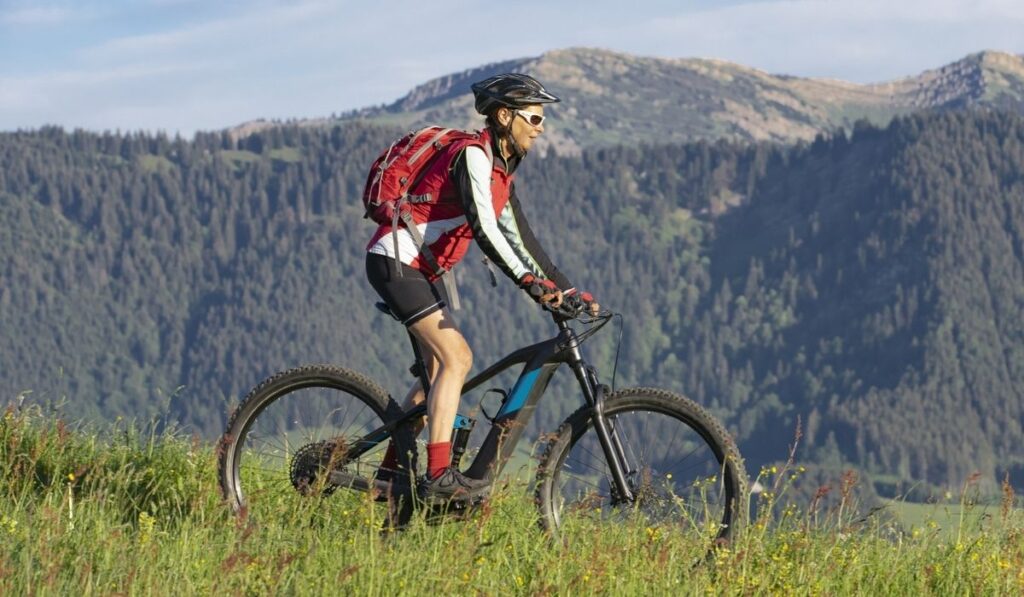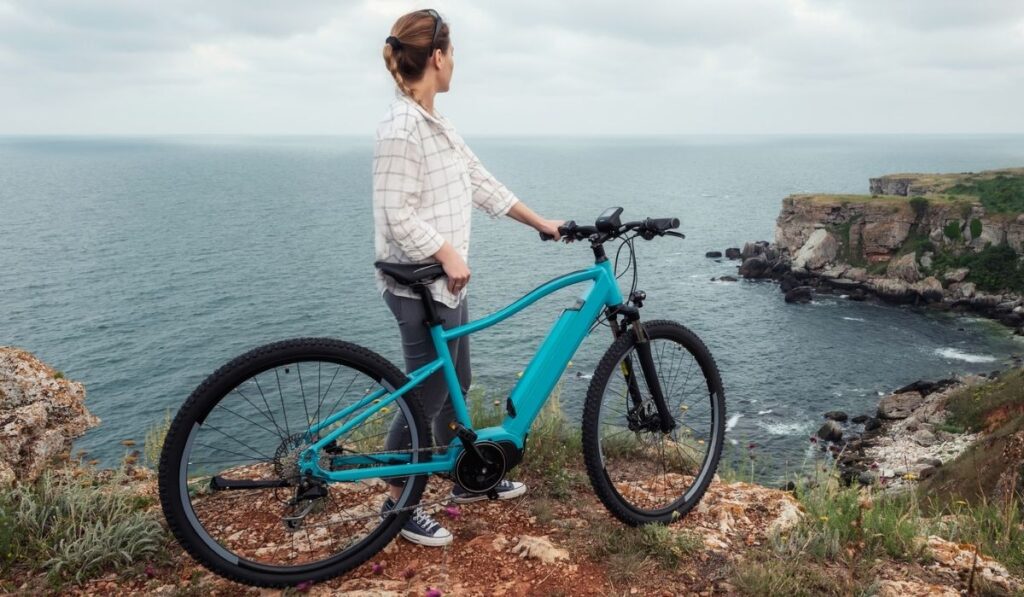Some riders are puritans and can’t see why you would want to even take a motor and battery into the wilderness. But, some of us want to push the limits of technology, nature, and ourselves. So, what’s the difference between electric mountain bikes (E-MTBs) and traditional mountain bikes?
E-MTBs have more power, range, weight, and speed than either a traditional mountain bike or a typical E-Bike. They have an easier time climbing hills and are better suited for mountain bike riders seeking added speed, comfort, and safety (for a significant price increase).
Conventional mountain bikes and their electric counterparts serve different purposes. They’re different tools entirely. So, when should you use one over the other? Is an E-MTB better for you? Read on to find out!
How are E-MTBs and Traditional Mountain Bikes Different

E-MTBs are going to be a bit heavier than your conventional mountain bike. The motor and battery of an electric bike can add a good 20lbs to a bike. Pair that additional weight with a full-suspension system, and you have a hefty model.
The added weight from these electrical components can make E-MTBs harder to maneuver than mountain bikes. E-MTBs might travel downhill faster due to the added weight, but doing tight turns might be a little more challenging.
However, E-MTBs can shine when going uphill. Pedal-assist capabilities can give you extra climbing power and reduce your fatigue, allowing you to stay out for extended periods.
When is an E-MTB Better than a Traditional Mountain Bike?
The short answer is that it depends. E-MTBs come in a range of categories that are suited for different riding styles. E-MTBs can be better for riders who want to go on longer rides, go downhill faster, and have an easier time climbing up steep hills.
You can find E-MTBs in three categories: power, all-around, and lightweight variations.
Power
Power E-MTBs are heavy and durable. This variation of the bike is terrible on roads but shine on uphill ascents. If your primary concern is climbing power, then Power E-MTBs are suited for you.
All-Around
All-Around E-MTBs are a good solution for those who want added power but not too much weight. These are typically lighter than Power E-MTBs, but offer excellent speed and control when going both uphill and down. These bikes are best suited to those who want an electric model that still feels like a bike.
Lightweight
Lightweight E-MTBs are best suited to those searching for an electric option that sticks closely to a conventional mountain bike. These bikes generally offer less motor assistance than the other options listed. Light E-MTBs are great for downhill sprints and riding next to those who don’t have added electric power.
E-MTBs do an excellent job of sticking to their traditional roots while adding additional speed. In general, these bikes are suitable for people seeking longer rides, less intensity, and added power.
How Much are E-MTBs?
I’m sure you already knew this, but: The price point of an E-MTB will depend completely on quality, type, brand, and distributor. Models can range from $800 to over $16,000! The entry-level range usually starts from around $800 to $1,800.
Low Budget
An example of an incredibly budget-friendly bike would be the ANCHEER 26″ Electric Mountain Bike (on Amazon). This model comes for under $800, making it a perfect first step into the sport. It’s a hardtail, meaning it only has a front suspension, which makes it suitable for single and double tracks.
Mid-Range Budget
A step up from that would be models in the $1,000 to $1,500 price range. The PASELEC Full-Suspension E-MTB (also on Amazon) is a great example of something in this price range. The full-suspension on this bike adds to the price but allows you to tackle more demanding terrain.
On top of that, you’re getting a more substantial battery and a higher-quality motor. A bike in this price range will typically have a longer range, better climbing speed, and higher quality parts.
Higher Budget
A short step just about that would be bikes priced in the $1,800 to $3,000 range. A bike on the low-end of this range would be the eAhora Rurui 750W Electric Bike (on Amazon). With this model, you get a much stronger motor and battery.
These components will give you the max motor-assisted speed of 28mph. The Rurui will allow you to tackle challenging terrain at high speeds, all while keeping your wheels firmly on the ground!
Models closer to the $3,000 mark, or above, are going to be better suited for those with a bit of experience in the game. If you’re just getting into the sport, a generally lower-priced model will do you just fine. But once you find out more about your preferences and riding style, you can start looking for upgrades with confidence.
Are Electric Mountain Bikes Worth It?

For the right person, a high-quality electric mountain bike will be well worth the investment. The right person for an E-MTB will be looking to travel further and faster when off-roading.
Range & Power
The battery and motor of an E-MTB allow for more range and power. Both of these components will enable you to tackle rough terrain for more extended periods with greater ease. Traditional mountain biking can leave you fatigued, causing you to cut long rides short. If you want to go on longer rides, using an E-MTB will be worth it.
Safety
E-MTBs are excellent choices for those prioritizing safety as well. Traversing highly technical terrain opens far more windows for injury. Beginners and veterans alike can benefit from the accessibility electric models provide.
Versatility
E-MTBs can also serve many different purposes. Even though these models are usually suited to the backcountry, you can still ride them in the city. Traditional mountain bikes are clumsy on asphalt at best. E-MTBs however have pedal assistance and added power, reducing this clunky feeling.
There are plenty of other reasons E-MTBs could be worth it for you. Electric mountain bikes are great for staying fit, families, and tech lovers alike. The speed and power of these bikes don’t just add utility but enjoyment as well.
Is Using an E-MTB Cheating?
The E-MTB community can often receive side-eye glances from traditionalists. Some riders don’t like the idea of souped-up bikes whizzing past them while they’re slowly trudging along. But, the future is now!
Using an E-MTB isn’t cheating. Sure, there have been instances where E-MTB riders have stolen records from traditionalists on Strava, but it’s generally accepted that those E-MTB riders are bad community members and give the sport a bad rap.
E-MTBs are a different tool from traditional mountain bikes entirely. They offer more speed, have different handling, and appeal to different users. The sports overlap, but neither side is better than the other. If you’re a conventionalist who dislikes electric mountain bikes, you should consider where that comes from. Maybe, you want one yourself!
On the other hand, if you’re using an E-MTB and feel like you are cheating, you may just want to go back to using a conventional bike. Both of these scenarios are perfectly acceptable. Conventional mountain bikes will be better suited to specific riders. It all depends on user preferences and needs.
When is a Traditional Mountain Bike a Better Choice
Traditional mountain bikes and E-MTBs both have clear advantages depending on the context of use. But what kind of situation would using an average mountain bike be better?
You’re on a Budget
If you were to compare an E-MTB and a conventional mountain bike of similar quality, side-by-side, which do you think would cost more? E-MTBs are usually going to cost more than traditional mountain bikes. The gizmos and gadgets of E-MTBs add up, hiking the price up with them. If you’re currently on a tighter budget, a classic mountain bike may be better.
You Don’t Want Restrictions
E-MTBs suffer from the unfortunate reality of restricted riding in certain places. Some trails may limit throttle use or types of E-MTBs that can be ridden there, depending on their classification. With a conventional bike, you’ll never have to worry about these rules.
You Don’t Want Extra Maintenance
Every bike is going to need maintenance sometimes; that’s just a fact of life. Without the added electrical components, traditional mountain bikes will take a bit less work. You can freely spray down your standard bike with a hose after a muddy run, but with an E-MTB, you’ll have to be much more careful.
You’re More Competitive
There’s no shame in wanting the speed and assistance E-MTBs can provide for riders. However, you may want to use a traditional bike if you’re more competitive or prideful. The work you put into each run, trail, and hill using a conventional model can’t be disputed. If you want to have more bragging rights, better to go with a traditional bike.
You Don’t Want the Added Weight
The added weight of an E-MTB affects every aspect of owning it. Transporting a heavier bike to the trail, followed by riding on the trail, can add a lot more fatigue. If you’re riding down far-out trails in the backcountry that require a lot of hiking to get to, you may want a conventional mountain bike.
How Fast are Electric Mountain Bikes?
E-MTBs are like other electric bikes; they have motor assistance up to a certain speed. You can reach higher speeds than the ones listed, but the motor will stop once you hit the maximum speed. Once you slow down again, the motor will kick back in.
The motor-assisted speeds are based on classification. The classification systems work like this:
- Class 1: Pedal-assist up to 20mph
- Class 2: Pedal-assist up to 20mph
- Class 3: Pedal-assist up to 28mph
For bikes with a throttle, the classifications are relatively similar. The main difference is the throttle is fully limited to 20mph for every classification.
Don’t be discouraged if you’re looking at Class 1 models. You’ll quickly reach higher speeds than the ones listed above. On top of that, Class 1 and 2 models are fairly fast-paced for new riders.
